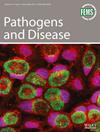Three-dimensional models of the cervicovaginal epithelia to study host–microbiome interactions and sexually transmitted infections
IF 2.7
4区 医学
Q3 IMMUNOLOGY
引用次数: 6
Abstract
Two-dimensional (2D) cell culture systems have provided controlled, reproducible means to analyze host-pathogen interactions. Although inexpensive, straightforward, and requiring very short time commitment, these models recapitulate neither the functionality of multi-layered cell types nor the microbial diversity of an infected human. Animal models have commonly been used to recreate the complexity of human infections. However, extensive modifications are commonly required to recreate interactions that resemble those in the human reproductive tract microbiologically and physiologically. Three-dimensional (3D) cell culture models have emerged as alternative means of reproducing key elements of human infections at a fraction of the cost of animal models and on a scale that allows for replicative experiments to be readily performed. Here we describe a new 3D model that utilizes transwells with epithelial cells seeded apically and a basolateral extra cellular matrix (ECM)-like layer containing collagen and fibroblasts. In this system, basal feeding creates a liquid/air interface on the apical side. The model produced tissues with close morphologic and physiological resemblance to human cervical and vaginal epithelia, including observable levels of mucus produced by cervical cells. Infection by both Chlamydia trachomatis and Neisseria gonorrhoeae was demonstrated as well as the growth of bacterial species observed in the human vaginal microbiota, enabling controlled mechanistic analyses of the interactions between host cells, vaginal microbiota and STI pathogens. Future experiments may include immune cells to mimic more closely the genital environment. Finally, the modular set up of the model makes it fully applicable to the analysis of non-genital host-microbiome-pathogen interactions. IMPORTANCE Infected sites in humans are a complex mix of host and microbial cell types interacting with each other to perform specific and necessary functions. The ability to understand the mechanism(s) that facilitate these interactions, and interactions with external factors is paramount to being able to develop preventative therapies. Models that attempt to faithfully replicate the complexity of these interactions are time intensive, costly, and not conducive to high throughput analysis. Two-dimensional (2D) models that have been used as a platform to understand these interactions, while cost effective, are generally limiting in experimental flexibility and structural/physiological relevance. Our three-dimensional (3D) models of the cervicovaginal epithelium can facilitate analysis of interactions between the host epithelium, sexually transmitted pathogens and bacteria present in the vaginal microbiota. Due to the modular design, additional cell types and environmental modulators can be introduced to the system to provide added complexity, approaching conditions in the infected human host.三维模型的宫颈阴道上皮研究宿主-微生物相互作用和性传播感染
二维(2D)细胞培养系统为分析宿主-病原体相互作用提供了可控的、可重复的手段。尽管这些模型价格低廉、简单明了,而且需要很短的时间,但它们既没有概括多层细胞类型的功能,也没有概括受感染人类的微生物多样性。动物模型通常被用来重现人类感染的复杂性。然而,通常需要进行广泛的修改,才能在微生物和生理学上重现类似于人类生殖道中的相互作用。三维(3D)细胞培养模型已经成为以动物模型的一小部分成本和允许容易进行复制实验的规模来复制人类感染的关键元素的替代手段。在这里,我们描述了一种新的3D模型,该模型利用顶部接种的上皮细胞和含有胶原和成纤维细胞的基底外侧细胞外基质(ECM)样层的Transwell。在这个系统中,基础喂养在顶端形成了一个液体/空气界面。该模型产生的组织在形态学和生理学上与人类宫颈和阴道上皮细胞非常相似,包括宫颈细胞产生的粘液水平。证明了沙眼衣原体和淋病奈瑟菌的感染,以及在人类阴道微生物群中观察到的细菌种类的生长,从而能够对宿主细胞、阴道微生物群和STI病原体之间的相互作用进行受控的机制分析。未来的实验可能包括免疫细胞,以更接近生殖器环境。最后,该模型的模块化设置使其完全适用于非生殖器宿主-微生物组-病原体相互作用的分析。重要性人类感染部位是宿主和微生物细胞类型的复杂组合,它们相互作用以发挥特定和必要的功能。了解促进这些相互作用的机制以及与外部因素的相互作用的能力对于开发预防性疗法至关重要。试图忠实地复制这些交互的复杂性的模型是时间密集型的、成本高昂的,并且不利于高吞吐量分析。被用作理解这些相互作用的平台的二维(2D)模型虽然具有成本效益,但通常在实验灵活性和结构/生理相关性方面受到限制。我们的宫颈阴道上皮三维(3D)模型可以帮助分析宿主上皮、性传播病原体和阴道微生物群中存在的细菌之间的相互作用。由于模块化设计,可以将额外的细胞类型和环境调节剂引入到系统中,以提供更高的复杂性,接近受感染人类宿主的条件。
本文章由计算机程序翻译,如有差异,请以英文原文为准。
求助全文
约1分钟内获得全文
求助全文
来源期刊

Pathogens and disease
IMMUNOLOGY-INFECTIOUS DISEASES
CiteScore
7.40
自引率
3.00%
发文量
44
期刊介绍:
Pathogens and Disease publishes outstanding primary research on hypothesis- and discovery-driven studies on pathogens, host-pathogen interactions, host response to infection and their molecular and cellular correlates. It covers all pathogens – eukaryotes, prokaryotes, and viruses – and includes zoonotic pathogens and experimental translational applications.
 求助内容:
求助内容: 应助结果提醒方式:
应助结果提醒方式:


